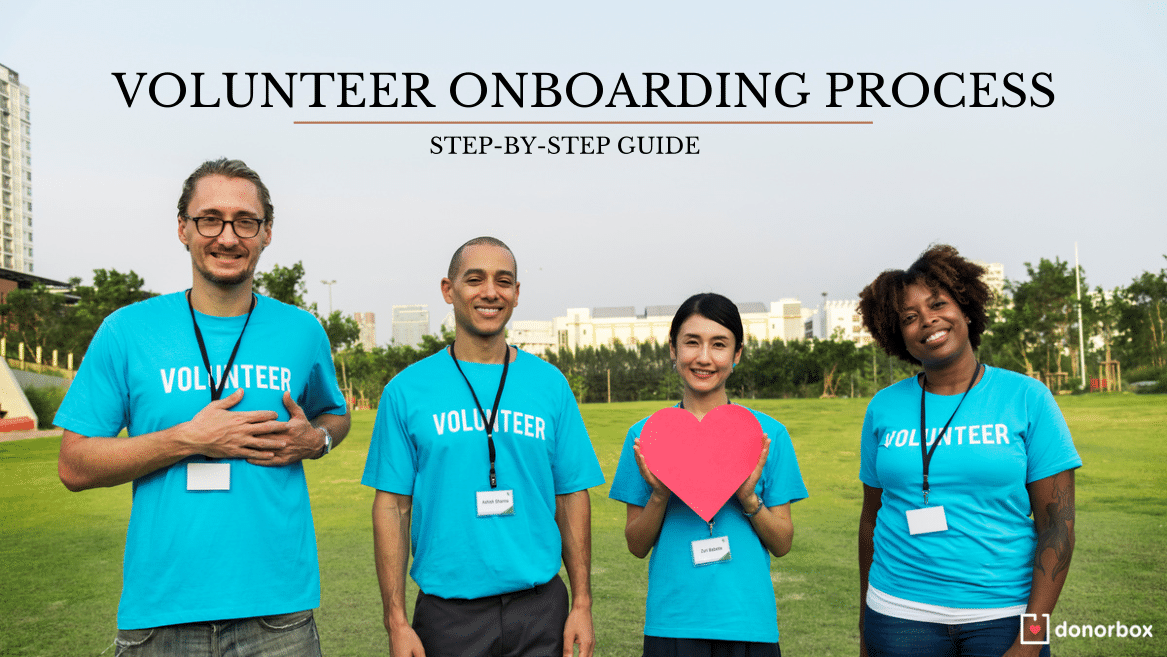Volunteer Onboarding Process | Step-by-Step Guide
You did it! You found the perfect volunteer. Only...now what? In this article, we'll walk you through the steps for the ideal volunteer onboarding process.

You did it! You found the perfect volunteer. Only...now what? In this article, we'll walk you through the steps for the ideal volunteer onboarding process.

Volunteer recruitment is just the first step in making sure your volunteers help your nonprofit fulfill its mission. Training and onboarding your volunteers may seem too time-consuming and unnecessary, but your nonprofit should take training volunteers as seriously as paid employees. Your volunteer onboarding process should include orientation, training, and regularly scheduled evaluations.
This article will help nonprofits prepare the onboarding manual and assist organizations in getting the most out of their volunteers.

Volunteers can come from all over. Regardless of their connection to your organization or reason for volunteering, it is best to treat each group of volunteers differently and find the best way to encourage long-term involvement with your organization. As you create your own volunteer onboarding process, think of the ways the volunteers have come to your organization. The following groups are 3 of the major ways you find new volunteers for your nonprofit.
We also have a Donorbox webinar dedicated to giving you more insight on finding your star volunteers –
Some volunteers may be family members or friends of your nonprofit’s beneficiaries. These volunteers already have a personal connection to the organization. These individuals will likely need little training to work with clients or the public and will likely need no extra convincing to continue volunteering or donating.
Others may want to volunteer with your organization to get school credit or fulfill their court-appointed hours. These volunteers are often dismissed and given short-term cleaning or repair projects. Some in this group may surprise you. By taking the time to train these volunteers, you are offering them new skills that will benefit them in the future. Combining skills training with new opportunities within the organization may turn a short-term volunteer into a long-term supporter and save the organization a lot of money.
The same is true for company groups who want to volunteer for your nonprofit. Often corporate volunteer days are viewed as cumbersome and time-consuming. But few nonprofits do anything with these new contacts once the day is finished.
This group of volunteers can help connect your nonprofit with the company they work for in numerous ways. Some of these volunteers may be perfect for your board, some can prove to be potential donors, and others can give you a way to further connect with company managers and owners. By doing your due diligence and connecting with the leadership of these groups, you may build vital community partnerships for your organization’s future.
Communication is key to getting each of these volunteer groups on the same page as the rest of your organization. Most volunteers will know very little about your nonprofit in the beginning. An onboarding process helps volunteers understand your nonprofit’s mission and purpose and get a clearer idea of their role within the organization.

Before any training begins, nonprofits must help volunteers understand the organization’s mission, programs, and policies. The purpose of creating an in-depth orientation can not only prepare volunteers for their work but potentially turn some volunteers into long-term donors or board members. This orientation manual will be the first step in creating a passionate supporter for your nonprofit.
Your organization’s mission is the foundation of your organization. The mission statement should state why your organization exists and how you hope to achieve your goal. Your vision can be a bit more involved and include a list of what you hope to accomplish.
When developing your manual, you can share your organization’s history and why it was created in the first place. In many cases, a nonprofit’s foundation story is interesting and inspiring. Telling volunteers about your organization’s story can help them feel like part of the nonprofit and excite them enough to share it with their friends and family. Your volunteer training manual should include both the organization’s history and a breakdown of all programs.

A list of policies and safety regulations will be an essential part of your volunteer orientation handbook. These policies and regulations will give volunteers a better idea of how the organization runs and a resource to check if they have concerns with staff or other volunteers.
Organizational charts detail staff roles and their relationships. Most also include contact information. Adding an organizational chart to your volunteer orientation handbook will give volunteers a better knowledge of who to contact and how best to reach them.
Another addition you may want to add to your volunteer orientation handbook is a list of all volunteer opportunities. Adding these may entice volunteers to take on more responsibility or share volunteer opportunities with others.

Now that your volunteers have been educated on the organization’s history, programs, and policies, it is time to move on to training.
One of the best ways to start training is with a webinar or video about volunteer activities. This is especially helpful if you have new volunteers coming in to do the same activity. You can include simulations and skits laying out specific examples and problems that may come up during their volunteer experience. You can also include a test section to help this information stick at the end of the video.
After your video or webinar, include a section where volunteers can get answers to any questions they may have. To make this even easier, your organization can add a FAQ section with past questions and answers.

Another way to help volunteers feel confident and ready to go is by giving them the chance to observe others performing the activity. By offering volunteers the opportunity to shadow a staff member or existing volunteer, they can see the action in real life and have another chance to ask questions they didn’t think of before.
Finally, including a brief description and the forms volunteers will use makes it simple to transition from learning to reality. Add a short description and copies of the actual documents.
After volunteers have finished training, it will help them and the organization to give each volunteer a mentor. As people become active in the organization, there will once again be more questions that come up. Attaching each volunteer to a mentor offers them, someone, they can talk with and share their ideas.
At the end of the observation and training process, your organization should ask new volunteers for their feedback on the experience. Be open to their viewpoints and make changes where you see the need.

Evaluation can benefit both the nonprofit and volunteers. With a well-thought-out process and strategy to turn short-term volunteer actions into long-term supporters, your nonprofit can strengthen these relationships and use these connections for additional ways to raise funds.
After hiring a staff member, you must include an evaluation and review process to monitor their success in a role and offer new positions and raises. The situation is no different for volunteers, except for the raises. Remember, one-time volunteers can turn into long-term volunteers, donors, and even board members depending on their involvement and how they are appreciated and helped through the transition.
Schedule regular evaluations for your volunteers. These evaluations can be with your development department, their volunteer mentor, or other members of your staff. Discuss with volunteers how many people they have helped and how their volunteering has saved the organization money.

As you discuss with volunteers how they have helped the organization, give them ways to increase their support. You can provide volunteers with a list of new opportunities and let them know about other ways to volunteer online through crowdfunding and peer-to-peer campaigns.
For those volunteers that genuinely stand out, it may be time to discuss board membership or create affiliate boards to start training for future board positions. If your nonprofit has different events and activities, this may be the perfect time to make smaller event boards. Let volunteers take on leadership positions with these boards and see what they can bring to the organization.
As a nonprofit, you will also want to track the progress of these volunteers for your own needs. Tracking volunteers gives your organization essential information needed for grant applications and reviews.
Each grant requires your nonprofit to provide detailed information on how staff and volunteers support your organization’s programs. To help give accurate reporting, you should track the following information.

Volunteers are a vital part of your nonprofit. Finding qualified volunteers to work with your programs, events, and on your board may take some time and effort, but the results are well worth it. Be sure to treat training and evaluating volunteers as seriously as you do your staff.
Donorbox offers nonprofits tips and resources to help with fundraising, volunteer management, and more. Donorbox is an affordable online donation processing system with no contract and no sign-up fee. Learn more about our features and how our system can help your nonprofit increase your fundraising and ensure long-term growth.

Subscribe to our e-newsletter to receive the latest blogs, news, and more in your inbox.